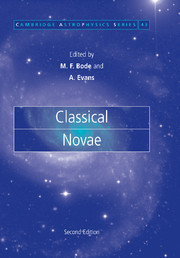Book contents
- Frontmatter
- Contents
- List of contributors
- Preface to the first edition
- Preface to the second edition
- List of symbols
- 1 Novae: an historical perspective
- 2 Properties of novae: an overview
- 3 The evolution of nova-producing binary stars
- 4 Thermonuclear processes
- 5 Nova atmospheres and winds
- 6 Observational mysteries and theoretical challenges for abundance studies
- 7 Radio emission from novae
- 8 Infrared studies of classical novae
- 9 Optical and ultraviolet evolution
- 10 X-ray emission from classical novae in outburst
- 11 Gamma-rays from classical novae
- 12 Resolved nebular remnants
- 13 Dust and molecules in nova environments
- 14 Extragalactic novae
- Object index
- Subject index
12 - Resolved nebular remnants
Published online by Cambridge University Press: 10 October 2009
- Frontmatter
- Contents
- List of contributors
- Preface to the first edition
- Preface to the second edition
- List of symbols
- 1 Novae: an historical perspective
- 2 Properties of novae: an overview
- 3 The evolution of nova-producing binary stars
- 4 Thermonuclear processes
- 5 Nova atmospheres and winds
- 6 Observational mysteries and theoretical challenges for abundance studies
- 7 Radio emission from novae
- 8 Infrared studies of classical novae
- 9 Optical and ultraviolet evolution
- 10 X-ray emission from classical novae in outburst
- 11 Gamma-rays from classical novae
- 12 Resolved nebular remnants
- 13 Dust and molecules in nova environments
- 14 Extragalactic novae
- Object index
- Subject index
Summary
Introduction
We may assume that all classical novae eject significant amounts of material (∼10-4M⊙) at relatively high velocities (∼ 1000 km s-1) and hence produce nebulae that ultimately may be spatially resolved (hereafter ‘nebular remnants’). The observation and modelling of such nebular remnants are important to our understanding of the classical nova phenomenon from several points of view. For example, combining imaging and spatially resolved spectroscopy allows us to apply the expansion parallax method of distance determination with greater certainty than any other technique (of course without knowledge of the three-dimensional shape and inclination of a remnant this method is still prone to error). On accurate distances hang most other significant physical parameters, including energetics and ejected mass. In addition, direct imaging of the resolved remnants can potentially clarify the role of clumping and chemistry in rapid grain formation earlier in the outburst (see Chapters 6 and 13). Remnant morphology (and potentially the distribution of abundances) can also give vital clues to the orientation and other parameters of the central binary and the progress of the TNR on the white dwarf surface. Finally, a fuller understanding of the nebular remnants of novae has implications for models of the shaping of planetary nebulae and (in at least one case) physical processes in supernova remnants.
- Type
- Chapter
- Information
- Classical Novae , pp. 285 - 307Publisher: Cambridge University PressPrint publication year: 2008
- 6
- Cited by



